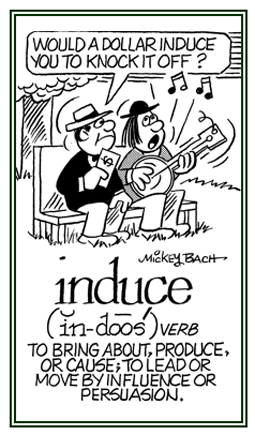duc-, -duce, -duct, -ducent, -ductor, -duction, -ductive, -ducer, -ducement, -ducation
(Latin: to lead, leading; bringing; to take; to draw along or out)
2. The transport of electric charges, under electric potential differences, by charged particles (called ions) of atomic or larger sizes.
In metals, the electric charges are carried by the electrons of inappreciable mass.
In solutions, the electric charges are carried by electrolytic ions, each having a mass several thousand times as great as the electron.
The positive ions move to the cathode (negative electrode) and the negative ions to the anode (positive electrode).
2. The conductivity of a medium in which the transport of electric charges, under electric potential differences, is by particles of atomic or larger size.
2. The production of electric current in a circuit when it is passed through a changing magnetic field.
3. Voltage produced in a coil as a result of the relative motion between the coil and magnetic lines of force; such as, flux linkages passing through the coil changes.
4. The production of an electromotive force in a circuit by the variation of the magnetic field with which the circuit is connected.
5. The generation of an electromotive force by changing the magnetic flux through a closed loop circuit, or by moving a conductor across the magnetic field.
This principle is the basis for the electric generator and electric motor.
2. A transverse wave associated with the transmission of electromagnetic energy.
The EPC has digits to identify the manufacturer, product category and the individual item.
2. The process in which electrons are added to a substance near the cathode of an electrolytic cell.
2. Modification in the distribution of an electric charge on one material under the influence of an electric charge on a nearby object which takes place whenever any object is placed in an electric field.
3. The production of an electric charge in an object when placed near a charged body.
4. A process of inducing stationary electric charges on an object by brining it near another object that has an excess of electric charges.
A positive charge will produce a negative charge, and a negative charge will produce a positive charge.
Motto of Indian River Community College, Ft. Pierce, Florida, USA.
The company's higher wages were actually inducing employees to work harder so their products could bring in more profits.
The day's hard work induced Patrick to go to sleep much faster when he went to bed.
2. To introduce or to bring a person into the knowledge of something; to initiate, to instruct: More people were induced to buy real estate, or houses, when they saw the interest rates go down.The warnings on cigarette packages has failed to induce millions of people to quit smoking.



